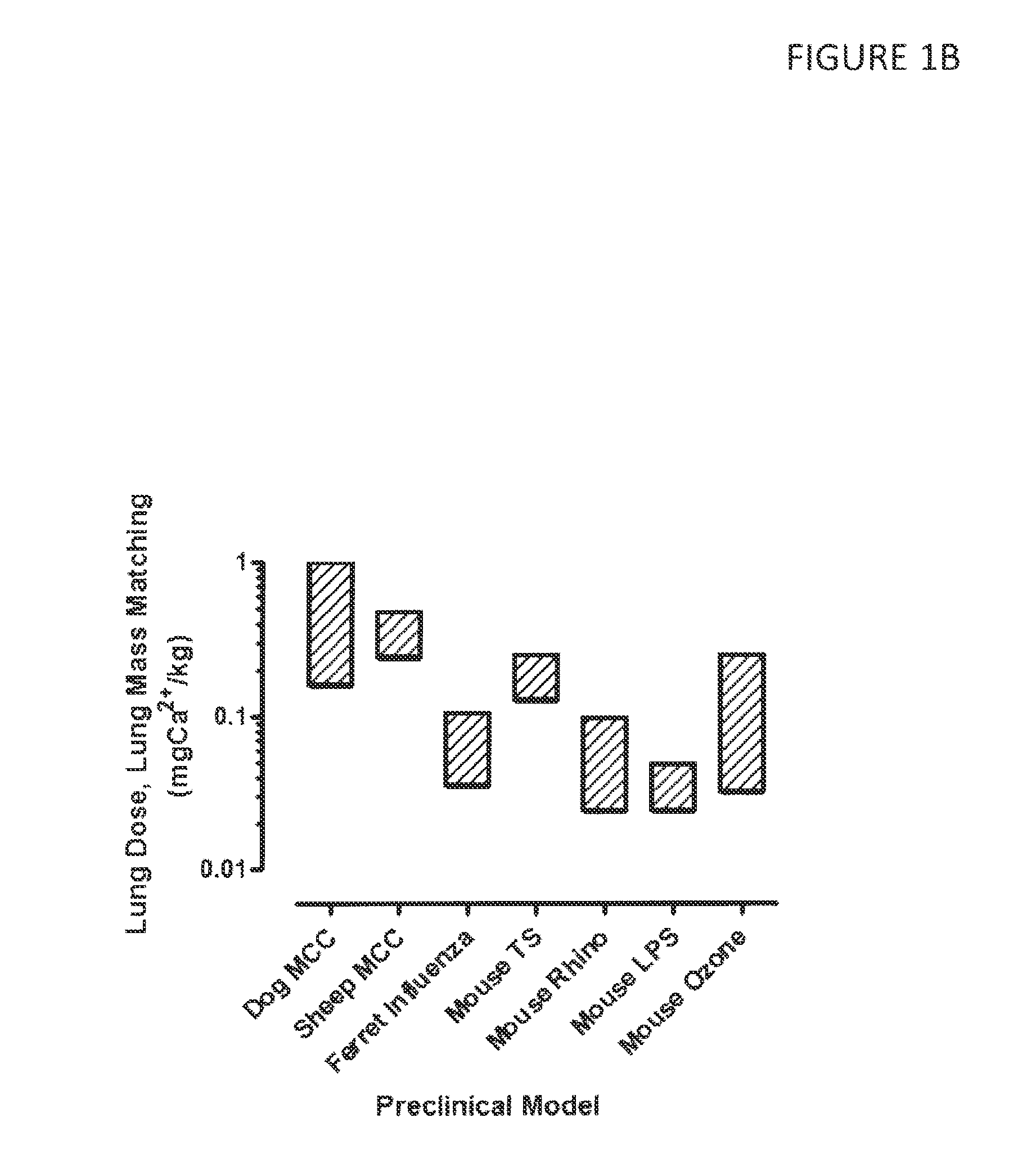Methods for treating and diagnosing respiratory tract infections
a respiratory tract infection and respiratory tract technology, applied in the field of respiratory tract infections, can solve the problems of increasing the burden or the rate of bacterial infection, and achieve the effects of increasing mucociliary clearance, increasing mcc, and little measurable increase in m
- Summary
- Abstract
- Description
- Claims
- Application Information
AI Technical Summary
Benefits of technology
Problems solved by technology
Method used
Image
Examples
example 1
Effective Doses of Calcium Ions Determined in Pre-Clinical Models
[0259]Calcium lung doses were calculated from various animal models of infection, inflammation and mucociliary clearance (MCC), shown in FIG. 1A-C. The animal models used are described in detail in PCT Publication Nos. WO 2012 / 030664 “DRY POWDER FORMULATIONS AND METHODS FOR TREATING PULMONARY DISEASES” and WO 2010 / 111680 “DRY POWDER FORMULATIONS AND METHODS FOR TREATING PULMONARY DISEASES”.
[0260]Briefly, in all preclinical models, aerosol concentrations and size distributions were measured at the point of aerosol exposure, which was typically by nasal inhalation. Exposure durations were controlled and minute volumes calculated for the animal based on empirical correlations such as e.g. that of Bide et al. J. App. Toxicol. 20:273-90 (2000) to determine the aerosol exposed dose. Empirically validated lung deposition parameters were incorporated for each species to predict lung deposition based on aerosol exposed dose.
[02...
example 2
Calcium-Containing Formulations Increased Airway Surface Lining (ASL) Height
[0265]Human Airway Cell Cultures:
[0266]The experiments detailed in this Example utilized cultured primary human bronchial epithelial cells (NHBE). These cells were obtained from excess tissue from donor lungs and excised recipient lungs that were obtained at the time of lung transplantation. Cells from the excised bronchial specimens were isolated utilizing protease digestion. Primary isolated cells were seeded (1×106 cells / cm2) on 12-mm permeable support (Transwell-Clear; Costar) pre-coated with human placental collagen. Cells were maintained under air-liquid conditions, washed every 48-72 hours to remove accumulated mucus, and studied as fully differentiated cultures (about 6 weeks, cultures with transepithelial resistances of greater than 200 ohms per square centimeter (Ω / cm2)). All incubations were performed in a well-humidified (about 95%) tissue culture incubator (5% CO2) at 37° C.
[0267]Measurement of ...
example 3
Calcium-Containing Formulations Enhanced Mucociliary Clearance (MCC) In Vivo
[0271]A calcium salt dry powder formulation, Formulation II, of 20% (w / w) leucine, 75% (w / w) calcium lactate, 5% (w / w) sodium chloride was evaluated in an established sheep mucociliary clearance (MCC) model. MCC was evaluated in groups of two to four healthy sheep by measurement of the clearance of pulmonary Tc99m-labeled sulfur colloid aerosols that were delivered by inhalation. The radio-labeled sulfur colloid aerosol was delivered to each of the sheep either immediately following (FIG. 3A) or two hours after (FIG. 3B) the completion of the treatment aerosol exposures and MCC determined via the collection of serial images for an additional 60 minutes. Animals were conscious, supported in a mobile restraint, intubated with a cuffed endotracheal tube and maintained consciousness for the duration of the study.
[0272]A rotating brush generator (RBG1000, Palas) was used to generate the dry powder aerosol. The si...
PUM
| Property | Measurement | Unit |
|---|---|---|
| concentrations | aaaaa | aaaaa |
| concentrations | aaaaa | aaaaa |
| diameter | aaaaa | aaaaa |
Abstract
Description
Claims
Application Information
 Login to View More
Login to View More - R&D
- Intellectual Property
- Life Sciences
- Materials
- Tech Scout
- Unparalleled Data Quality
- Higher Quality Content
- 60% Fewer Hallucinations
Browse by: Latest US Patents, China's latest patents, Technical Efficacy Thesaurus, Application Domain, Technology Topic, Popular Technical Reports.
© 2025 PatSnap. All rights reserved.Legal|Privacy policy|Modern Slavery Act Transparency Statement|Sitemap|About US| Contact US: help@patsnap.com



